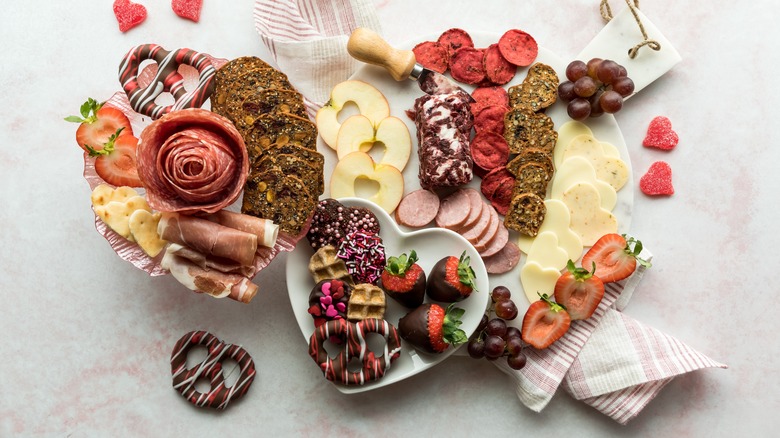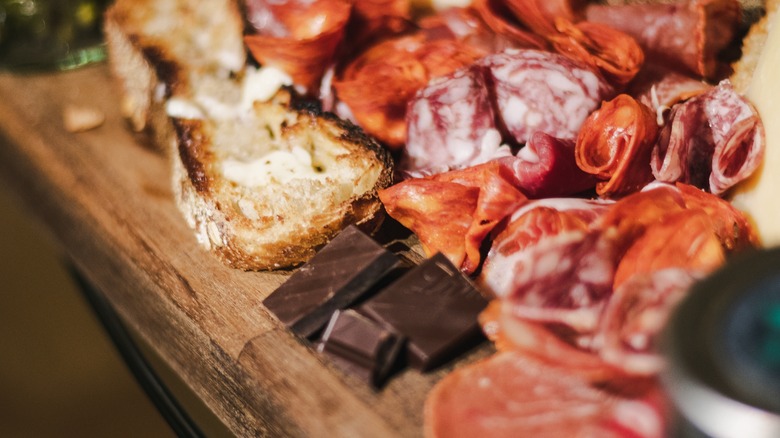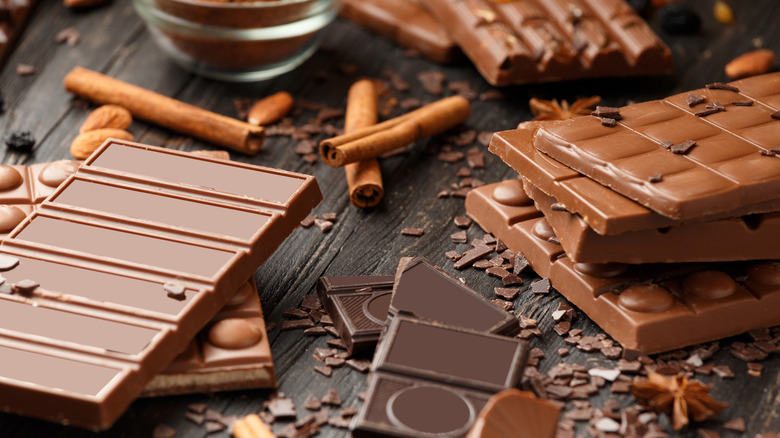How To Perfectly Pair Chocolate, Cheese, And Meat On A Charcuterie Board
An exciting, delectable charcuterie board isn't just one that's visually appealing. You want to incorporate depths of complementary and contrasting flavors and textures, leaving eaters with something thrilling in every bite. But if you're new to charcuterie boards, finding the right cheeses can be intimidating enough. And the more elements you add, the smarter you have to get with your pairings.
Luckily, Daily Meal spoke with expert Matthew Rose, ACS CCP, CCSE, Partner at Fairfield and Greenwich Cheese Company, to learn the unique ways to pair usual charcuterie suspects like cheese and cured meats with chocolate, one ingredient you may not have thought to add to your charcuterie board. But Rose doesn't think adding meat is always necessary. "I think there definitely is a possibility of having some success pairing chocolate and cured meats ..." he said. "... A good, high-quality bar chocolate has plenty of complexity, and it would be more satisfying to focus on just the cheese and the chocolate." If you can't fathom a charcuterie board without cured meats, follow some of Rose's suggestions to find success.
The best meats for a chocolate and cheese charcuterie board
"For me personally, I love to pair Speck, which is like a prosciutto but it is cold-smoked, so it has the added flavor of the smokiness that I think works really well with chocolate," Matthew Rose divulged. Prosciutto is already one of the best types of meat to use for a charcuterie board, so if you're already familiar with the salty, creamy ham, Speck is not too far off. As Rose mentions, the distinct smokiness is what sets Speck apart. More bitter chocolate seems like a strong match for the smokiness of Speck, playing off of your bite of chocolate with a dense, savory flavor.
"Italian Bresaola, an air-cured beef round that is washed with various herbs and spices and wine, could also lend itself to pairing with chocolate and cheese," Rose shared. Instead of using cured pork, a commonly used charcuterie meat, Rose advises cured beef. While Bresaola may be a less familiar cured meat, don't underestimate its powerful flavors, especially with the addition of spices and herbs that can act as a flavor bridge between your meat, chocolate, and cheese. The deeper savoriness of this cured beef can be more impactful when paired with bold chocolate than a smooth, fatty, cured pork like prosciutto could ever be.
The interplay between chocolate and other charcuterie board ingredients
When making a charcuterie board, it's best to organize your ingredients first so you can visualize how you should construct the board and put everything together. However, you also need to consider the many ways eaters will enjoy each ingredient together. Matthew Rose specifically considers chocolate to play an important role. "The chocolate can have an interesting interplay with the other elements on the board ... sometimes the acidity and the texture of a good quality chocolate bar can function nicely as a palette cleanser in between nibbles of lots of other foods," he advised.
Perhaps making chocolate the accessory of your board, scattered in the empty spaces, is the best way to encourage guests to enjoy it as a small bite in between the main event of the board: The cheese and meat. Make sure your cheeses and meats match the same intensity of your chocolate, especially if you're featuring a unique, high-quality chocolate bar. This helps ensure no flavors get lost, guaranteeing boldness in every bite.


